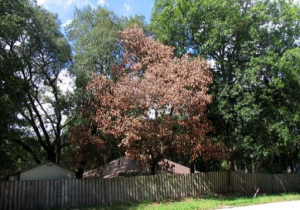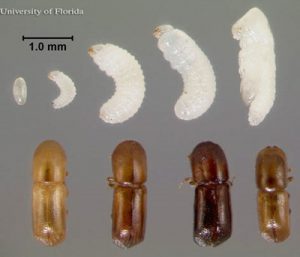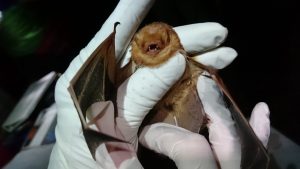by Sheila Dunning | Mar 1, 2017

Swamp Redbay Tree infected with Laurel Wilt. Photo credit: Sheila Dunning
Many invasive plants and insects are introduced in packing materials, including 12 species of ambrosia beetles, which embed themselves in wood used as crates and pallets. While these tiny beetles don’t actually feed on wood, the adults and larvae feed on fungi that is inoculated into galleries within the sapwood by the females when they deposited their eggs. While the ambrosia fungus keeps the beetles alive, it kills the host tree. This is the projected fate of redbay trees (Persea borbonia) due to the Redbay Ambrosia Beetle.
First detected in the United States in a Georgia trap in 2002, Xyleborus glabratus, the Redbay Ambrosia Beetle, caused substantial mortality of redbay in northern Duval County, Florida in 2005. This ambrosia beetle introduces fungal spores, (Raffaelea lauricola) from specialized structures found at the base of their mandibles into the vascular system of plants when boring into host trees of the Lauraceae family. This insect and disease complex has collectively been named “Laurel Wilt.” Infected redbays, assafrass and avocado trees wilt and die within a few weeks or months.

Ambrosia Beetle life stages
The Redbay Ambrosia Beetle is a shiny black, cylindrical insect about 2 mm in length. The males are flightless and the females can only fly short distances (1 – 1.5 miles). Therefore, host trees are often attacked many times and stands of redbays are damaged quickly. Small strings of compacted sawdust may protrude from the bark at the point of initial attack. However, wind and rain easily remove this sign leaving the only symptom to be the total browning of foliage in a section of the tree’s crown. Since the fungus blocks the xylem (water-carrying) tissue of the redbay, it appears to wilt while leaves remain attached. Once infected, the trees cannot be saved.
To avoid spreading the beetle and pathogen to new areas, the trees need to be cut down and wood or chips from the infested trees should not be transported off site. Where allowed, the materials should be burned on site. Protection of unaffected trees is possible with expensive pesticides if applied in a timely manner and using the correct techniques. Removal of all susceptible tree species is not recommended. The survivors may hold a genetic tolerance.
by Carrie Stevenson | Mar 1, 2017
Special Guest Blogger – Lorraine Ketzler, Biological Science Technician with US Fish and Wildlife Service
There have been several fungal invaders entering and spreading within the US in recent years and I’d like to draw attention to four of them:

Eastern red bats being surveyed for White-nose Syndrome at Talladega National Forest, AL. Photo credit: Lorraine Ketzler
- White-nose Syndrome (WNS) in bats (Pseudogymnoascus destructans)
- Chytridiomycosis (Chytrids) in frogs (Batrachochytrium dendrobatidis)
- Chytridiomycosis (B-sal) in salamanders (Batrachochytrium salamandrivorans)
- Laurel wilt disease (Raffaelea lauricola) in Lauracea family trees (redbay, sassafras, avocado and others), transferred by the invasive redbay ambrosia beetle (Xyleborus glabratus).
These diseases have devastating effects on multiple species. Bats, frogs, and salamanders are important insect predators, and all species –including trees- cycle nutrients through ecosystems to provide carbon storage benefits as well as other services. Bat populations in North America are declining precipitously as WNS marches westward across the continent. Many frog populations across the globe have disappeared because of Chytrids, with several species recorded as extinct and some are being listed under the Endangered Species Act. In addition to nutrient cycling, Lauracea trees benefit humans as food crops, aromatic ornamental trees, and medicinal plants. However, Laurel wilt disease is found in nearly every county in Florida, and continues to spread throughout the southeast.
The state and the US must remain vigilant and monitor against the introduction of B-sal, a recently discovered and highly transmissible disease spread through pet trade salamanders. It has not yet been observed in the US, but has caused widespread declines in native salamanders of the Netherlands and UK.
Unprecedented numbers of new and emerging pathogenic fungi continue to be discovered. Fungi genomes are amazingly adaptable, overcoming plant and animal defenses, and becoming resistant to fungicides. Increasing human traffic, trade, and disturbance introduce these pathogens to new habitats. Trade ports are key introduction sites. Always practice decontamination procedures when handling wildlife and native plants, even in areas without confirmed infections to prevent the spread of disease to new populations.
Help Stop the Spread of Non-native Species



